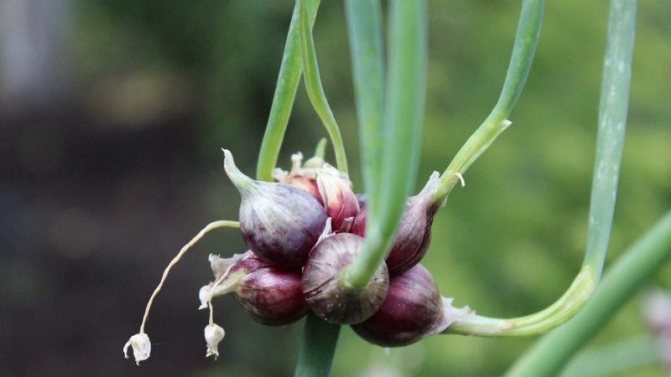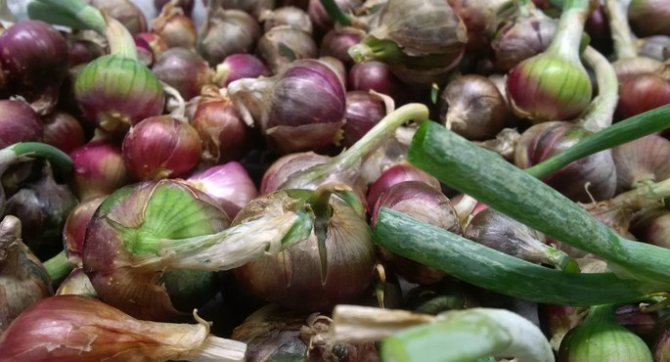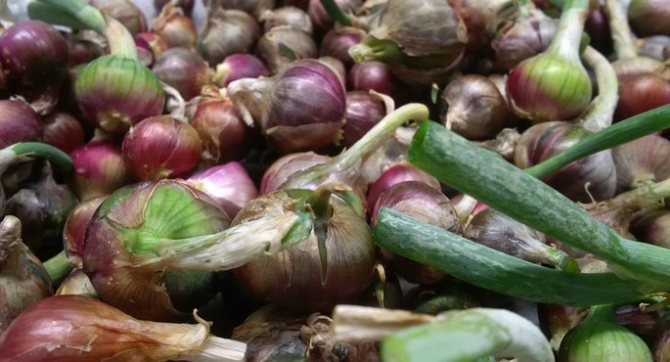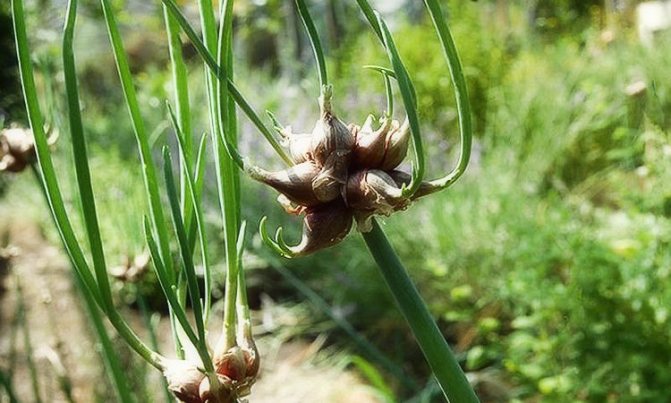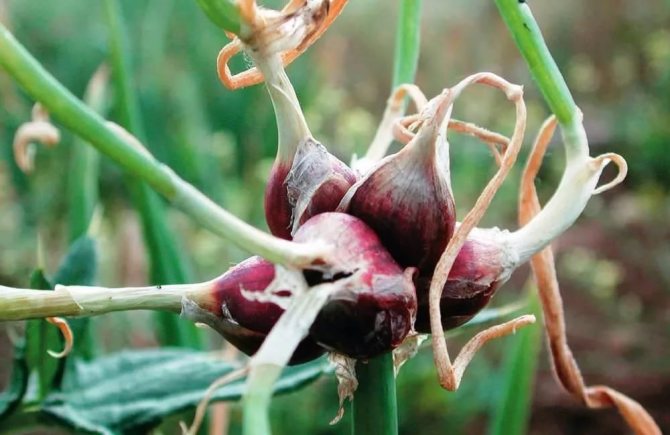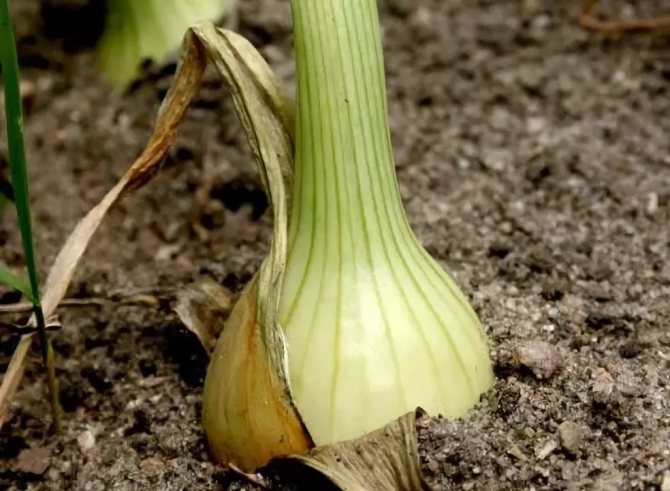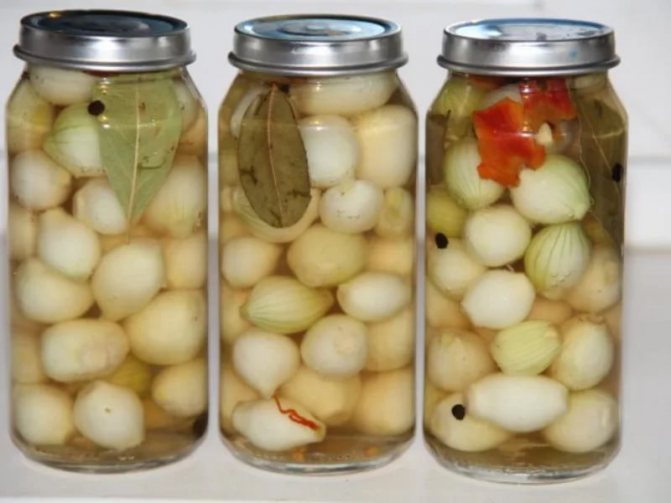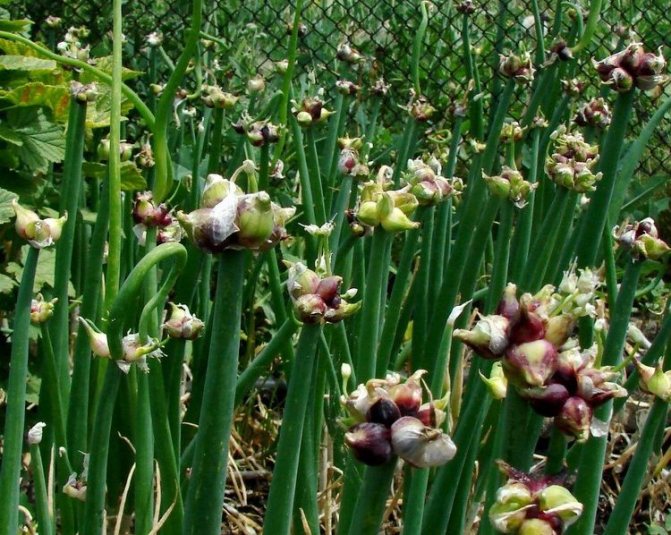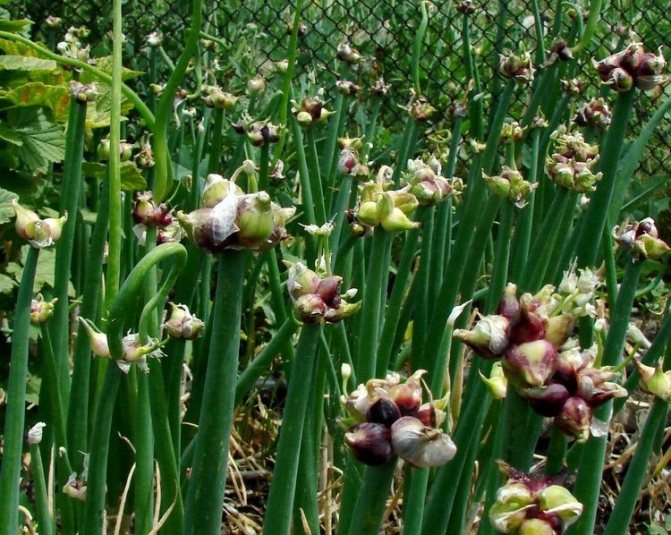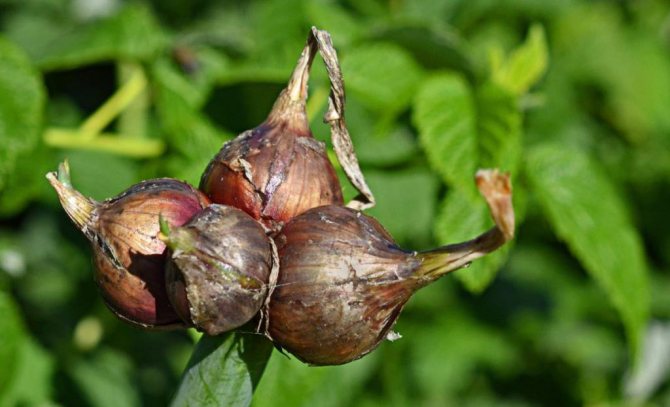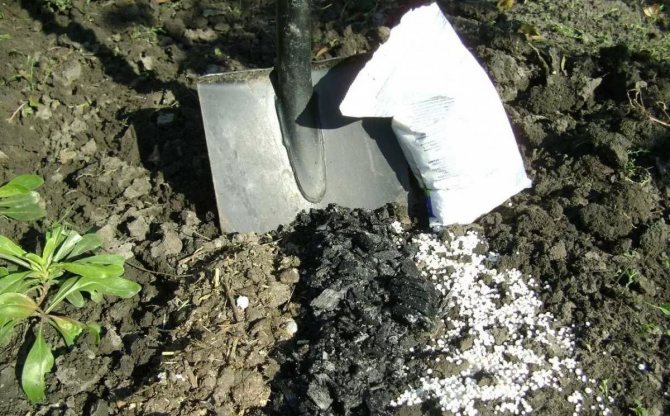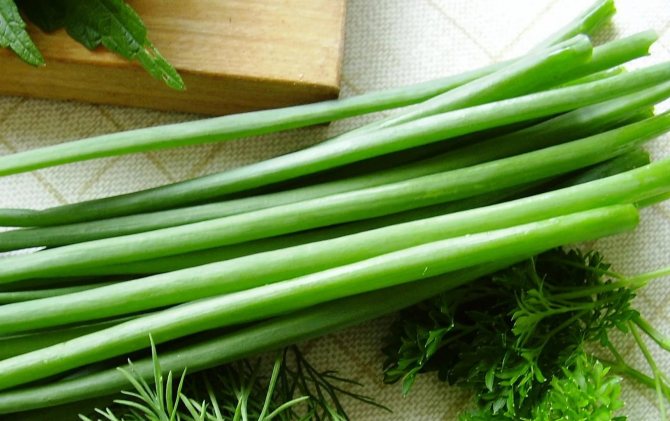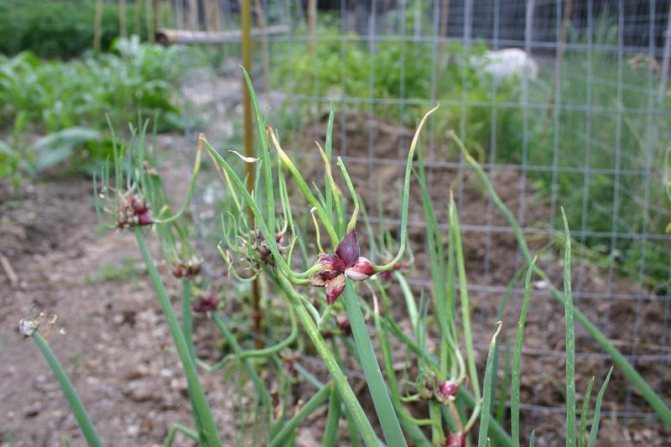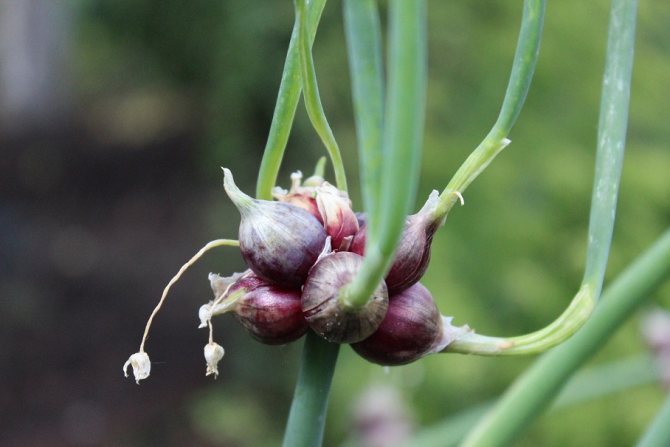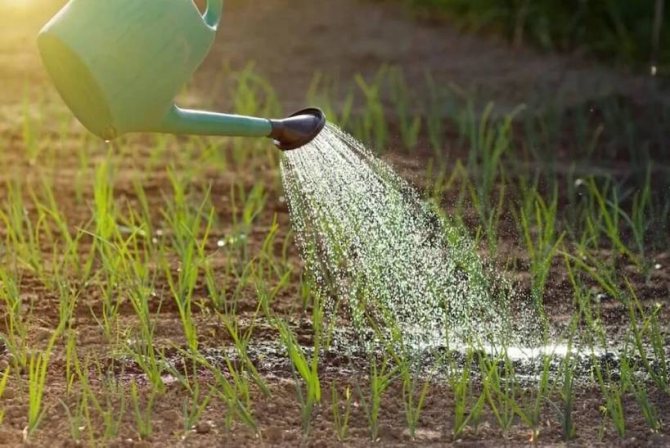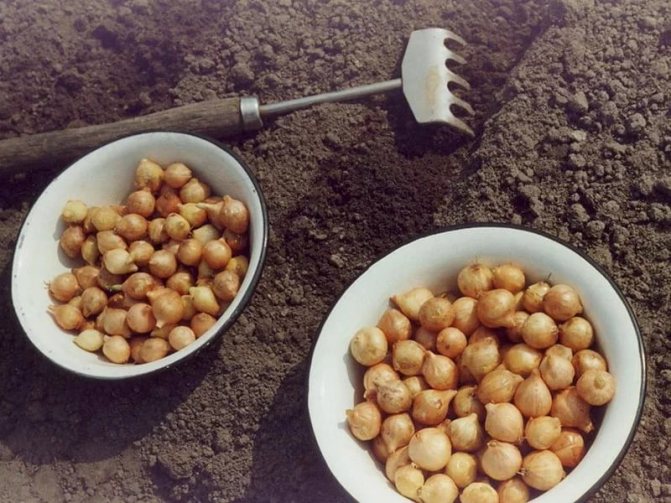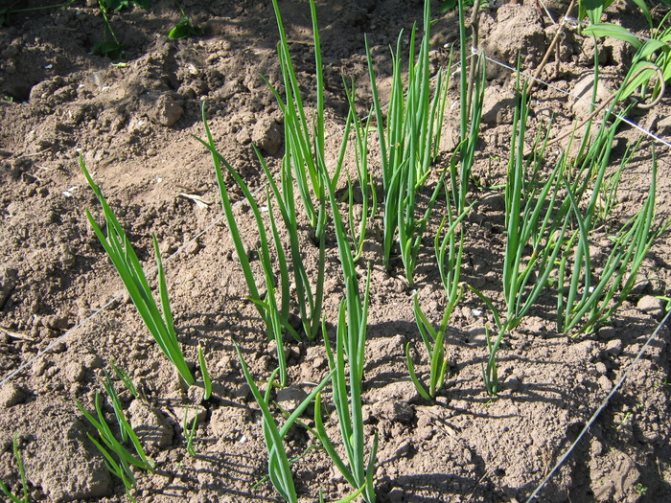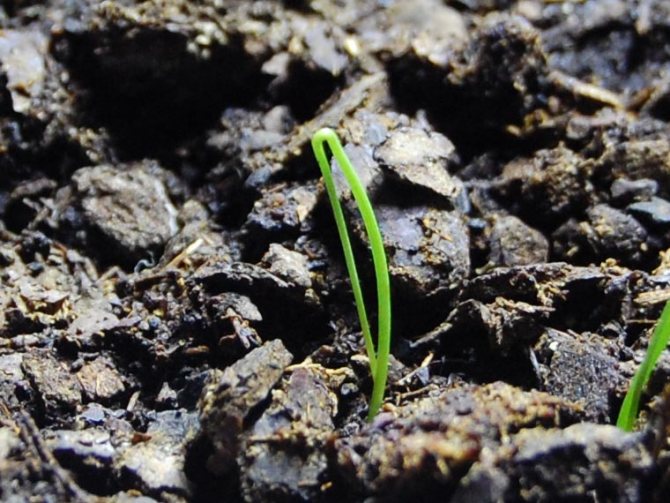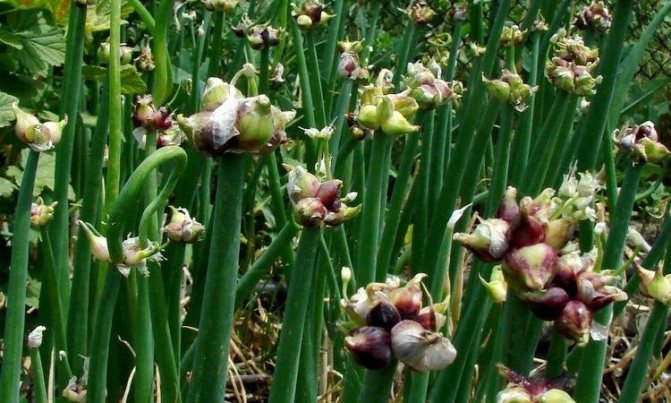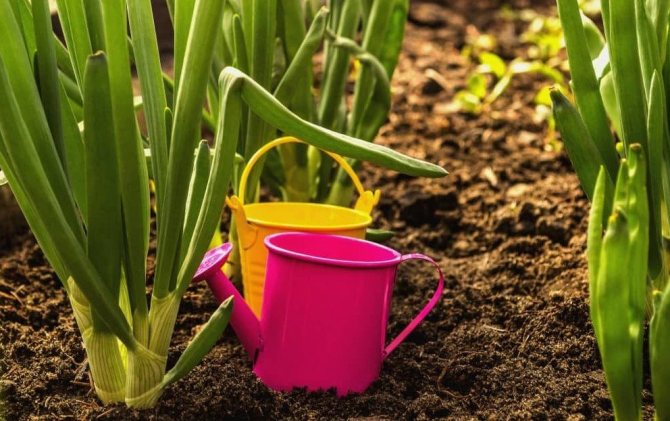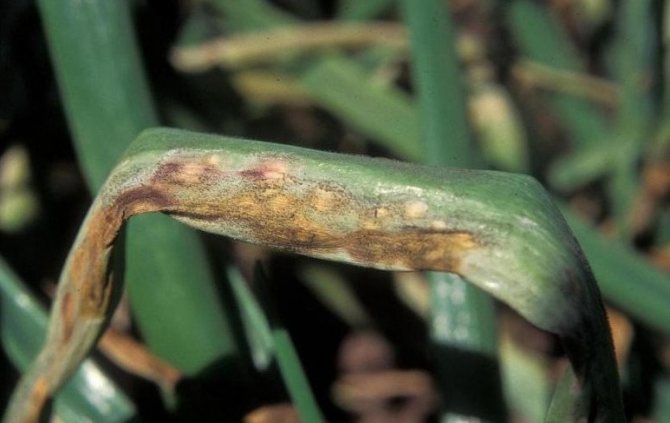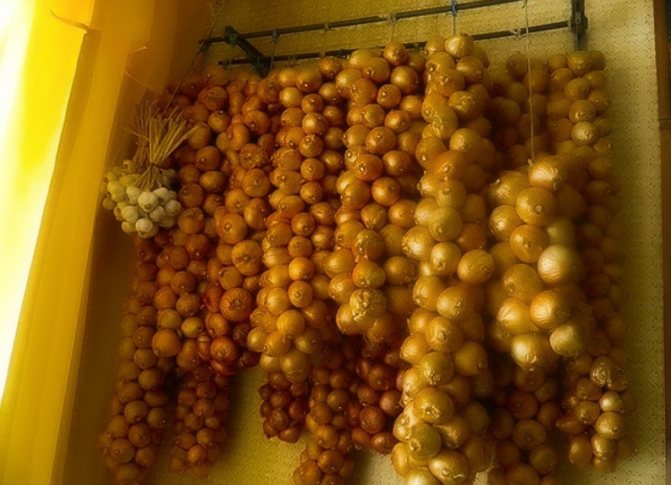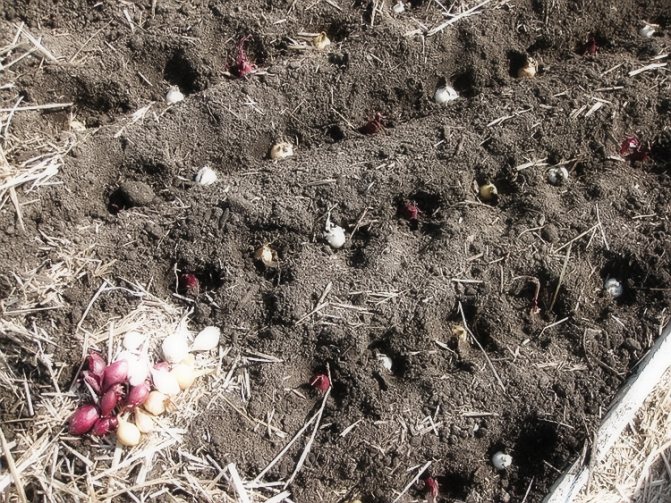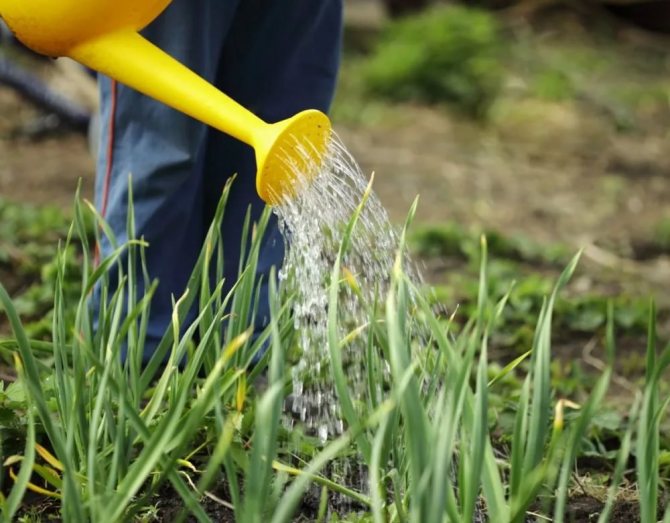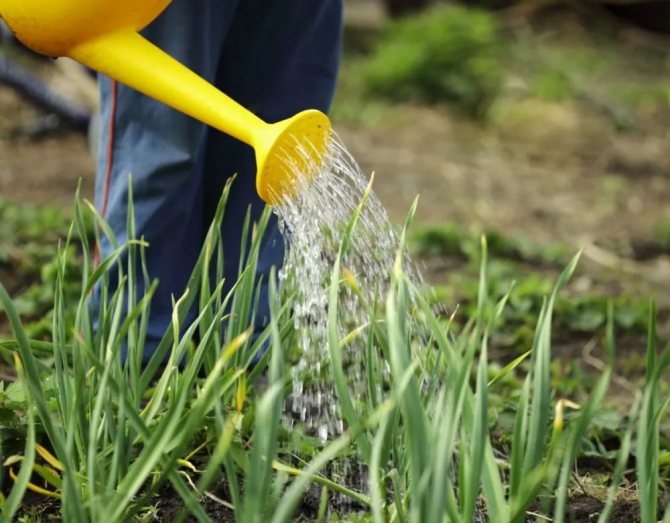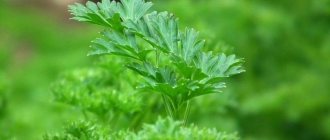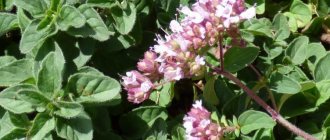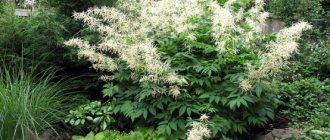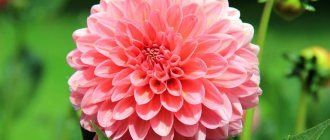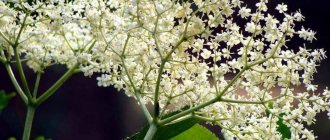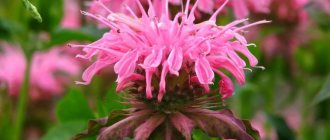Author rating
The author of the article
Yakov Pavlovich
Professor, Head of the Department of Vegetable Growing
Articles written
153
Frost-resistant multi-tiered onions are not often found in summer cottages. It is just beginning to gain popularity due to its increased cold resistance and the ability to produce greenery with the onset of the first warmth and the melting of snow. Without a transplant, the plant can grow in one place for several years, after which it is necessary to allocate a new fertilized bed for it. They eat only greens, and the underground part is suitable for reproduction.
Types of onions
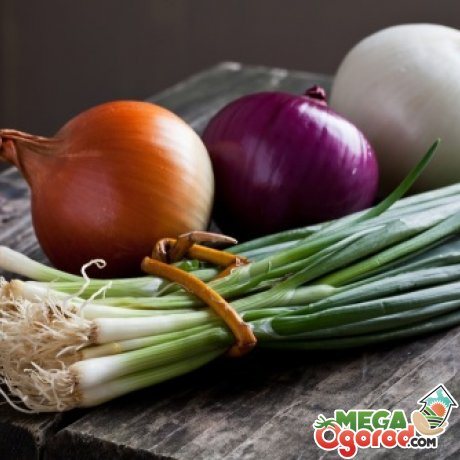
The plant has a rich species diversity - about 1000, but in our gardens it is customary to grow only edible species. There are not so many of them, but these species are densely included in the human diet. Moreover, they have healing properties that are known even to children.
Among the great variety of species in gardens, the following are more often grown:
- Onion-batun - this type of plant belongs to perennials, only its leaves are eaten. Greens ripen throughout the season - from spring to autumn. The trampoline is able to withstand frost, it is absolutely unpretentious.
- Chives - This plant can be grown as an ornamental plant, but its leaves are cut for salads and other gourmet dishes. The greens are juicy, tender and tasty. It grows throughout the season.
- Shallots - this type of onion differs from the onion in taste. It is softer and more juicy, less pungent. However, the bulbs are much smaller. Dishes with it are aromatic and tasty. It is this type that is more often used for the preparation of medicinal broths and infusions.
- Slime - This type of onion is distinguished by its leaves. They have a delicate taste and resemble garlic. Only leaves are used for food, this species has no root crops. The species is cold-resistant.
- Leeks - Prized for their pleasant onion flavor and lack of tears when chopped. Used in food all over the world.
Onion - this type of onion is known to everyone and is widely grown as the main onion crop. Both root vegetables and feathers are eaten. Onions can be stored well if they are harvested and grown correctly on time. The taste of onions is tart, spicy.
Garlic-onion - this species has already become so isolated that many do not even know that this is an onion. Garlic has a rather pungent and bright, pungent taste. Not a single preparation and meat dish can do without it. Grown everywhere.
Gardeners, as a rule, plant several types of onions at once - onions, batun and chives. These are one of the most popular species in the beds of summer cottages. They are unpretentious and delight with greenery all season.
Useful properties and application
The three-tiered bow has a rich chemical composition, which includes:
- phytoncides;
- vitamins;
- trace elements necessary for the body;
- amino acids.
Greens have antibacterial, phytoncidal and antimicrobial properties. It also contains antioxidants and some substances that help cleanse the body of toxins.
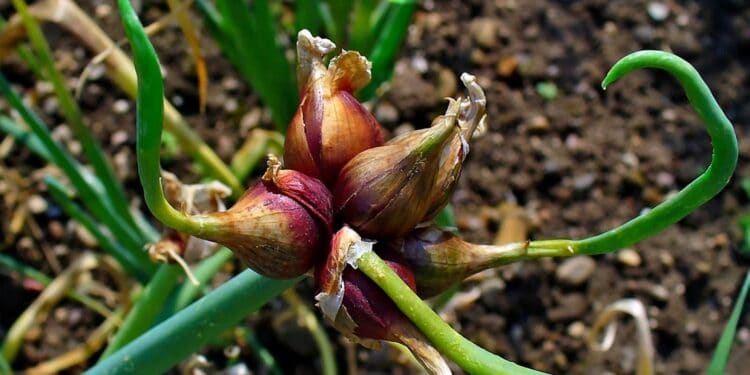

Onion breeding methods
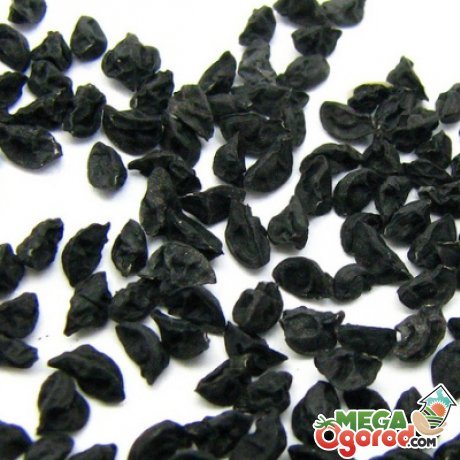

Depending on the type of plant, the best breeding method is determined. For example, onions are usually grown from sets. Seed material is obtained from seeds that are formed at the end of the growing season - an arrow is released. Usually gardeners buy ready-made sets and do not philosophize with seeds.Onions and garlic are propagated vegetatively - by cloves or children, which are formed on the root crop. Other types of onions are more commonly propagated by seed.
Some species are perennials and reproduce by self-seeding, for example, batun.
Schnitt can be propagated by dividing the bush. It is advisable to do this when the plant reaches 4 years of age. The same species is propagated by seeds.
The breeding method depends on the type of onion and the gardener's preferences. Some people like to propagate the plant by seeds, someone is more convenient vegetative way.
How viviparous onions multiply
Reproduction of multi-tiered onions is carried out only in a vegetative way, since the plant does not form seeds. For planting, use air bulbs from the first or second tier. You can also propagate this variety by dividing the bush. The plant is completely dug out of the ground, the underground part is divided and planted in a new place.
Suitable for planting are air bulbs harvested at the end of summer or at the very beginning of autumn. Before the onset of cold weather, they must have time to take root.
Planting culture
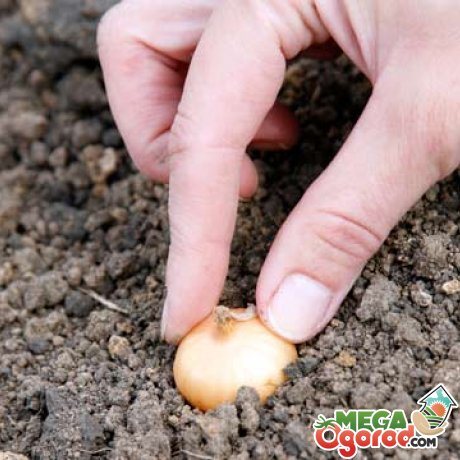

Onions love sunny locations and can grow in almost any soil. However, if the gardener set out to grow a large crop, the land should be loose and fertile. Onions do not tolerate acidic soil, so it is acidified with lime, wood ash or dolomite flour. It is preferable to use the latter additive, since a mixture of humus and lime is impractical. Nitrogen in this tandem will not be enough for full development.
- Landing features:
- The soil is prepared in the fall. To do this, dig up the earth, add humus and compost to it. Ash or lime should be added only in case of increased acidity of the soil. In the spring, the soil is dug up again and a complex of mineral fertilizers is applied.
- Planting onions is carried out when the ground is warmed up to the length of the index finger.
- The sowing should be planted to a depth of no more than 3 cm, if the soil is heavy - by 1.5 cm.The distance between the bulbs is on average 8-10 cm, between the rows - 20 cm.
- After planting, the garden bed can be mulched with humus or compost. Shoots will appear in a week.
Proper care of onions
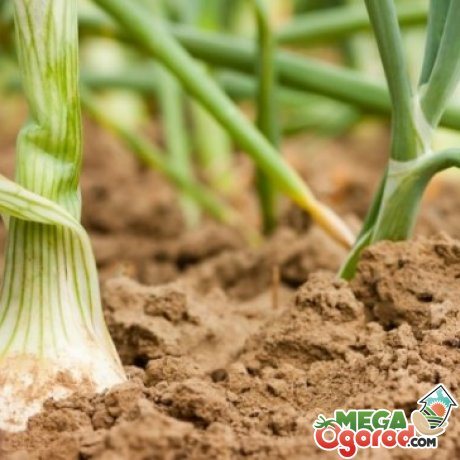

For the successful cultivation of onions, it is not enough to fertilize once. The culture needs to be looked after - watered, weeded and fed. This is the only way to grow really good onions.
During the period of feather growth, the culture needs to be watered two to three times a week - the first decade of development.
As soon as the growth of the bulb itself has begun, watering is reduced to once a week. If the summer is rainy, you do not need to water the onions. This culture does not like dampness. In hot and dry summers, you can water the plant once or twice every 10 days, but no more. Two weeks before harvesting, watering is stopped altogether. Onions do not like weeds very much. Therefore, try to keep the garden clean. Pull the weeds out in time. Moisture lingers on the overgrown garden bed - the onion does not like this, the root crop can rot or become infected with a fungus.
If you want to harvest a good harvest of onions, you need to fertilize on time. This rule applies to poor, un-enriched soil. If enough fertilizers, organic and mineral, have been applied to the ground, then additional fertilizing is not necessary. Determining the deficiency of any substance is very simple. If the feather of the onion is pale green, there is not enough nitrogen. The feather turns yellow, which means there is not enough potassium. Dry nibs indicate a lack of phosphorus.
Onion feeding rules:
- In the first decade of growth, nitrogen fertilizers are applied to the ground, for example, ammonium nitrate.
- In the second decade, phosphorus-potash fertilizers are introduced. When the bulb begins to form and grow, you can add another batch of phosphate-potassium fertilizers.
- However, the third feeding is not necessary.Many gardeners have noticed one feature of the plant - the roots become larger and juicier when watered with brine. The soil around the bulb is generously sprinkled with salt and watered. This measure is used to control the onion fly - its larvae and then the worms do not like salty soil. The method has proven itself and made it clear that salt not only drives away flies, but also improves the taste of onions. It is recommended to sprinkle the ground with salt twice a season.
The main thing is not to overfeed the culture. If the plant has juicy, green feathers, it does not need feeding.
Harvesting
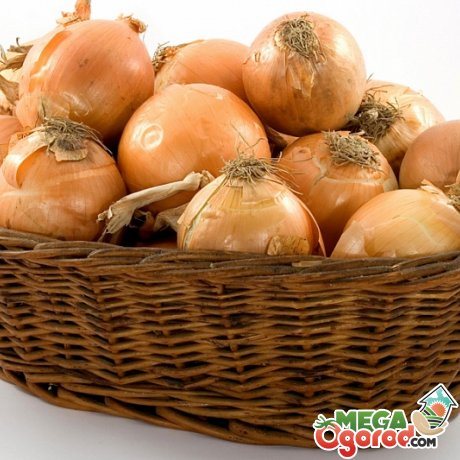

You can determine the readiness of a vegetable by its feathers - they arise, dry out and fall to the ground. The neck between the greenery and the fruit begins to dry out. When this happens, the bow can be harvested. The main thing is not to overexpose it in the garden, otherwise the keeping quality of vegetables will greatly fall.
Root crops are carefully removed from the ground and laid out to dry, but not at home, but on the street. It is worth taking care that the rain does not wet the crop when drying. The onions should dry for about a couple of weeks. After that, the dried feather is cut off at a distance of 3-4 cm from the bulb. The roots are also pruned. Next, the onions are placed in wooden boxes and stored in a dark place - home pantries, cellars or rooms.
Growing large onions is not so difficult, the main thing is to provide the culture with fertile, loose soil and properly care for it.
The only thing that cannot be controlled is the weather. If the summer is not successful, it is cold and damp, then you should not count on a large harvest, despite all the efforts and correct agricultural technology. But if the summer is warm, then every gardener can grow a generous harvest.
More information can be found in the video:
Growing tricks
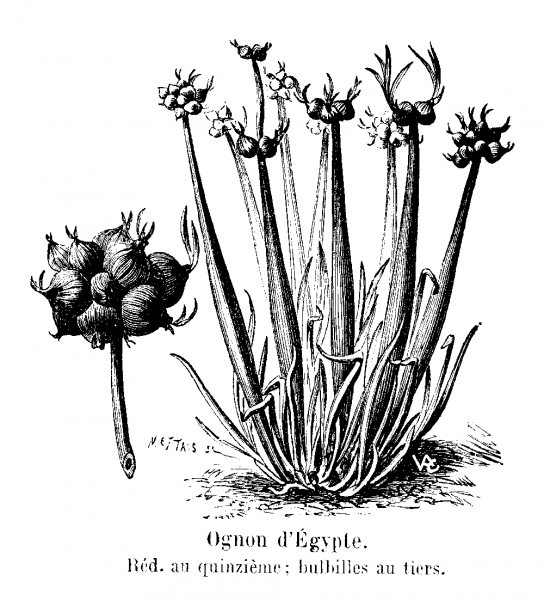

Here are some actionable tips on how to grow a rich harvest of Canadian onions:
- It is advisable to cover the soil with allium with dense material in early spring. Onions are not afraid of frost, but sharp fluctuations in temperature can destroy the plant.
- The collected bulbs dry out quickly, they are immediately planted or stored in the cellar, refrigerator.
- It is required to remove all weeds at the planting site, especially rhizome weeds.
- It is better to plant large and small bulbs next to similar in size, then there will be an even distribution of space between them, as well as the same requirements for watering and ripening times.
- The number of underground bulbs increases every year, so plantings are thinned out in the spring, giving the bulbs more space for development.
- The best candidates for collecting planting material are 3-4-year-old plants with a developed structure.
- In dry years, air bulbs are preferable to collect in July, by August they will dry out or turn yellow.
Vegetative propagation of onions
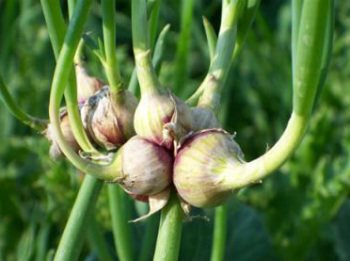

In the northern regions of our country, a perennial crop of onions from a sample without renewal through seeds is widespread. This is the so-called vegetative propagation of onions. It has existed for a very long time. As a result, special varieties have developed with a long stage of vernalization, with a large number of bulbs in the nest.
Now this bow is distributed throughout the country. It is diverse in shape, color, nest size, feather thickness and height, and other features. It is interesting in that it gives large nests, up to 10-20 bulbs, is well stored in a warm, dry room in winter, does not require worries about growing planting material or seeds. However, the material selected for planting must be stored at a temperature of 18-20 degrees.
Planting onions are taken from healthy, well-formed nests. The diameter of the planting bulb is 2 to 3 centimeters. Larger bulbs should be cut before planting. But cut onions are more easily attacked by pests.
Vegetatively propagated onions are planted simultaneously with the set or somewhat later, until May 20. The distance between the plants is 20-25 cm. The bulbs should be planted shallowly, up to the shoulders, since they normally grow only on the soil surface. on top, the planted bulbs are mulched with semi-rotted manure. The manure retains moisture and serves as additional nutrition for the onion.
Forming a large nest with a rather weak root system, vegetatively propagated onions are especially responsive to the presence of moisture and nutrients in the soil; with a lack of them, the tips of the leaves turn yellow. Frequent and plentiful watering before the beginning of bulb formation, that is, in May-June, is especially favorable for increasing the yield.
The onions are fed two or three times: the first time - after regrowth, the next - 10 days later, one after the other. It is very important to keep the soil loose, especially when the bulbs are forming. Onions ripen 65-95 days after planting, depending on the variety. It is harvested and dried in the same way as when growing onions from sets.
Requirements for conditions
A multi-tiered onion does not cause any difficulties when growing, it is frost-resistant, as well as drought-resistant, and can grow anywhere. But in order to get the first green arrows as early as possible, you need to select rich, breathable loamy soils for this culture. Wet, acidic and heavy soils are unsuitable for viviparous onions.
See also
Description of the Slizun onion variety, features of cultivation and careRead
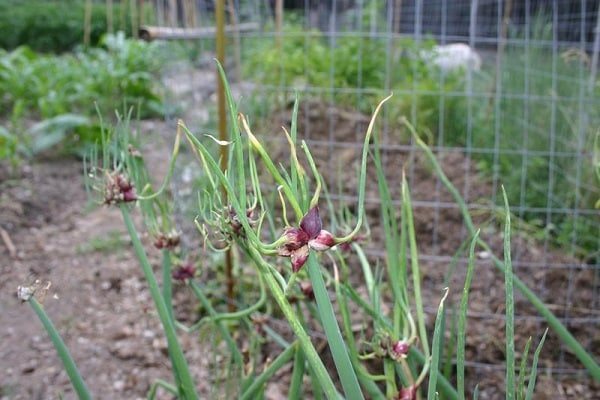

When the substrate is swamped, the underground bulbs quickly rot. A well-warmed and sunlit area is most suitable, from which snow cover early in spring and water does not retain.
An important condition for growing and getting an early harvest will be the timely application of organic fertilizers. It is recommended to plant this onion crop after beets, zucchini, potatoes, radishes, cabbage, cucumbers, legumes.
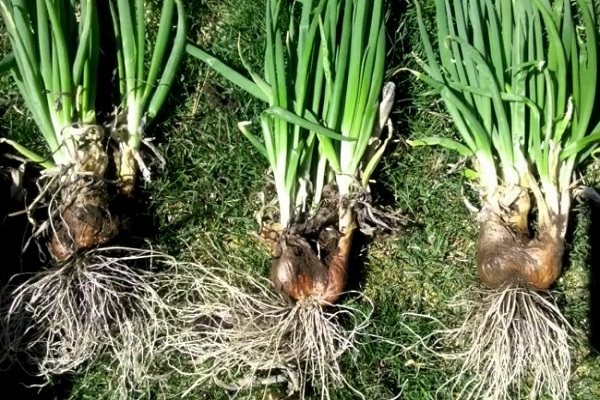

Planting onions
The principles of planting onions "for food" and for decorative purposes are the same. The main rule: do not plant onions after related cropsso that the bulbs do not rot and there are no other diseases. But tomatoes, cabbage, peas and beans are excellent predecessors.
Drop off location choose a light, warm one so that the sun warms the soil. For decorative bows, this is also an important condition for a beautiful color. And for onions, light and warmth are juicy onions and bright greens. In addition, the loose, warm soil reduces the risk of rot.
For onions, light and warmth are juicy onions and bright greens.
Onions love soil fertile, well seasoned with organic and mineral fertilizers, with a reaction close to neutral. As a rule, the onion bed is prepared in advance. It can be planted both before winter (early autumn) and in early spring. Before winter, they usually plant onions "on a feather" in order to delight themselves in spring with fresh herbs, but if you follow simple rules, then you can also on a turnip.
Before winter, they usually plant onions "on a feather" to delight themselves in the spring with fresh herbs
I planted sets (small onions grown from seeds) several times before winter, but in the spring it very quickly began to shoot at the expense of greenery and bulb formation. After reading the article about winter onion planting, I realized: for this, you need to choose a set of no more than 1-1.5 cm in diameter.
In the spring, sevok is planted in the first ten days of May in well-warmed soil... The only problem in this case is its preservation in winter: small bulbs can dry out. And yet, if planted in soil, the temperature of which is less than +12 degrees, the onion will quickly begin to shoot. But you shouldn't be late with planting either - this can affect the development and quality of the bow later.
Description of the plant
The plant got its name due to the peculiarities of the development of the aboveground part.
Green leaves stretch from the ground, and instead of inflorescences, airy bulbs are formed, from the junction of which new peduncles with bulbs emerge. Thus, the onion grows in several tiers.
China is recognized as the homeland of this plant. It was there that shoots of a similar species were first discovered. Then the onion came to Europe and only in the 17-18 centuries. got to Russia.
The leaves have a hollow structure, they are thick, up to 2 cm in girth, rich green and juicy. The height of each shoot is usually 40-50 cm, but some extend up to 1 m. Inflorescences are represented by a collection of air bulbs, the total number of which ranges from 3 to 30 at one point of convergence. The diameter of each depends on the tier, the lower they are located, the larger. The first level contains onions, the size of which is up to 3 cm, weight up to 25 g. The upper tiers include fruits weighing no more than 4 g.
Horned onion is distinguished from the classic varieties of onion by a sharper and richer taste and excellent frost resistance. Bulbs tolerate winter colds up to 50 degrees.
Unlike other species of the family, the multi-tiered onion begins to grow when the air warms up to 10 degrees. Bulbs do not have a dormant period, they continue to develop on the peduncle constantly. The underground organ grows in full force by September.
Using a tiered bow
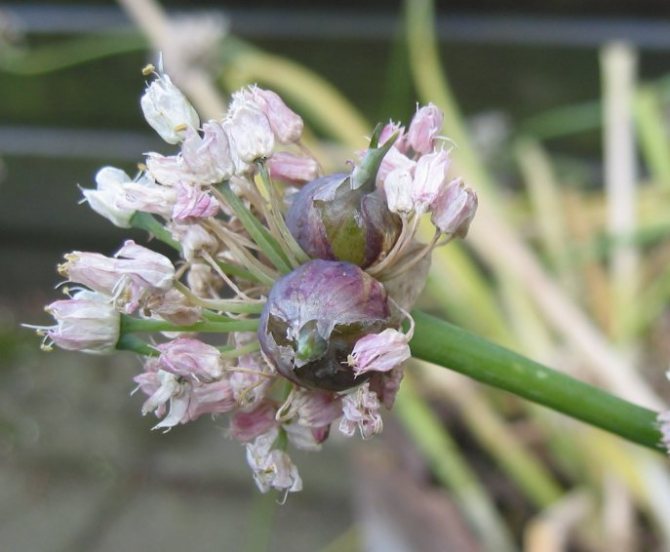

This plant is primarily for food purposes. Both shoots and bulbs (underground and aerial) are edible, regardless of whether it is a wild variety or grown in your summer cottage. Leaves and bulbs have a richer and more pungent flavor than other onions. They are more nutritious, contain more vitamins. The leaves are eaten fresh in spring and early summer, the bulbs are salted and pickled.
Thanks to the phytoncides contained in the composition, parts of this plant allow their use as a means of traditional medicine. The components increase immunity, protect against colds, help fight gum disease, vitamin deficiency, hypertension and gastrointestinal problems.
The use of allium in ornamental gardening is also popular. Thanks to its interesting inflorescence-bulbs, multi-tiered structure, early flowering, it has a practical role in gardening. In landscape design, the following applications are possible:
- For a parterre garden. Will be a suitable element due to the early appearance of greenery.
- As a decorative framing of tracks. Allium is planted at a short distance from the edge of the path and from the next plant. A few weeks later, interesting and unconventional framing of the tracks is observed.
- As an integral part of a rock garden, a rocky hill. The height of the plant allows it to be used as one of the central elements, surrounding it with shorter neighbors. The decoration of such a decorative garden with stones (gravel, crumbs, boulders) looks beautiful.
- As an integral part of the allaria. This type of garden composition involves the use of only various types of bows. Pick up 1-2 high center elements, surrounding them with undersized ones. Also the flowering period and characteristic color. Allarius will delight the gardener all year round. The following varieties become neighbors of a multi-tiered bow: shnitt, anzur, bear, blue, oblique, Pskemsky, Ostrovsky.
The peak of the plant's decorative effect comes in the summer, and by July-August the bulbs are removed.
Varieties
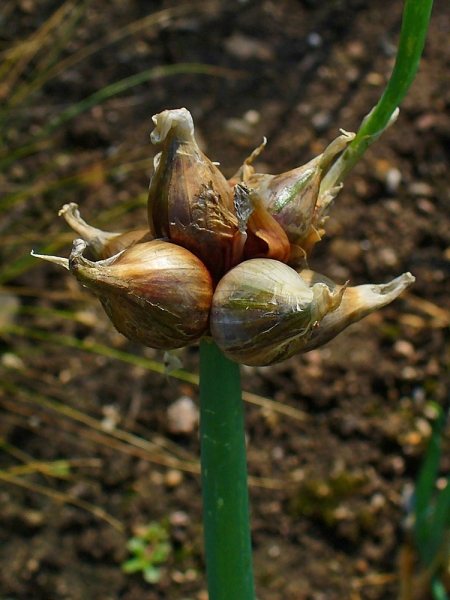

There are several popular variants of viviparous onions. The most common types:
- Memory. An early variety with fast germination and excellent green mass growth. The period before cutting the leaves is about 24 days. In one procedure, 1.5 kg of greens are removed from 1 sq. m, and up to 3 kg per season, of which up to 0.7 kg are extracted from air bulbs. Purple, elongated bulbs usually grow in 3 tiers.
- Likova. Harvesting begins 20 days after planting, even if the amount of sunlight is low.The shoots have a waxy bloom, the bulbs are greenish-purple in color, oval, weighing about 6 g, combined into inflorescences of 3–8 pieces. Productivity - 3.6 kg per 1 sq. m.
- Odessa winter. Shoots are light green, about 30-40 cm tall. The bulbs are oval, reddish-purple, up to 30 air bulbs per plant.
- Chelyabinsk. The ripening period of the first crop is 20 days. The variety is resistant to cold weather.
- Gribovsky 38. The shoots of the first tier are extended by 40 cm, 2 more layers are slightly less. The ripening period is 21 days.
All varieties are highly branched, tolerate cold well.
Onion care
Watering
Onions need moisture to develop properly. Many sources say that it makes sense to water the onion once a week.
Onions need moisture for proper development.
But in 2013, for example, the summer was fickle: either the sun was hot and the tips of the onion feathers dried out in a couple of days, or it was raining when the bulbs were already formed (the bulb ripening process began in July), and watering was not particularly required. In this case, you need to watch that the onion does not dry out, but does not overflow. Greens will be the first to know about excess moisture - it will turn pale green.
Fertilizers
If the onion does not go into greens for a long time, it makes sense to feed it with liquid fertilizers. 1 liter is perfect. urea +1 glass of mullein. After a couple of weeks, you can feed again.
Loosening and weeding
It makes sense to loosen the soil around the onions several times a week, but I usually limit myself to one time.
It is better to loosen onions several times a week.
Must be weeded beds with onions. Last summer, I planted it in different places: one was in the open sun, and the other was in a warm, sunny place, but with a fickle sun. I was in no hurry to weed the onion growing on the very "ashes" - I just broke through the most aggressive weeds so that they would not drown out the little feathers, and when the onion gained strength, the weeds can be removed. This helped to protect young feathers from drying out and wilting for a while.
Anti-fungus treatment
Many gardeners, when the feather reaches 15 cm, process the foliage with a solution of copper sulfate in order to prevent fungus. I didn’t, and while the fungus bypasses my bow. My grandmother loved to add 1 tablespoon of laundry soap, grated and dissolved in water, to the solution of copper sulfate.
Multi-tiered onion recipes
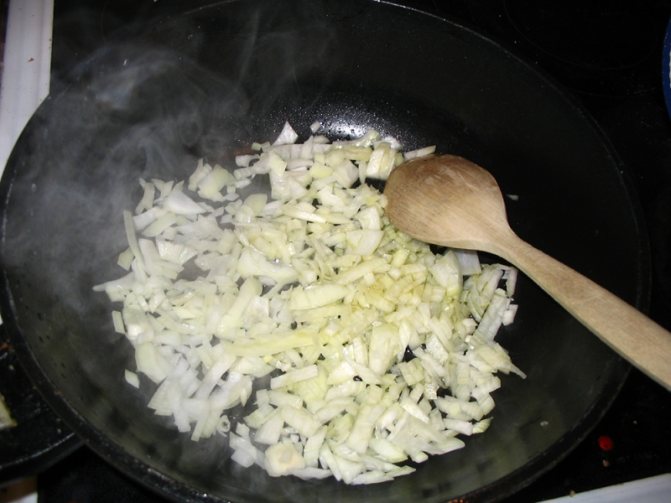

This useful plant is used for making salads, soups, marinades, pie fillings and sauces. Popular recipes include the methods below.
Pickled onions with berries
Such a product will also be beneficial in the winter. It is prepared in this way:
- Trim the top and bottom of the bulb, remove the husk.
- Put the required amount of bulbs in boiling water, remove and cool.
- Pour the cooled onions with well salted water.
- Mix 0.7 kg of currant or gooseberry juice with 0.3 kg of apple cider vinegar, 2 tbsp. l. sugar and salt, a little cloves and pepper.
- Bring the mixture over a fire until bubbles appear, but do not boil.
- Put a bay leaf on the bottom of a glass jar, tamp the onions tightly, pour marinade over.
- Sterilize containers for 10 minutes, then screw the lids back on.
Egg salad
To prepare a dish, use the following recipe:
- Finely chop the onion leaves, resulting in about 1 cup of chopped product.
- Grind 3 eggs.
- Mix ingredients, top with mayonnaise. You can add hot peppers or some vinegar.
Caramelized onions
This delicious and quirky snack is easy to make with Egyptian onions. The work progress is as follows:
- Peel several small bulbs, with a total weight of about 150 g, cut off the bottom (if the bulbs are large, then cut into wide rings).
- Put in a frying pan with allium oil, fry over medium heat.
- When the onion is softened and covered with a light brown crust, pour 15 g of sugar, a little salt into the container, pour in 2.5 tsp. balsamic vinegar.
- Stir the ingredients and simmer for 12-15 minutes.
Jam
Onions are not only suitable for main courses and appetizers, they are also used to create sweet dishes. Cooking steps:
- Peel 0.25 kg of onion and remove the bottom.
- Rinse the bulbs and chop finely.
- Put the product in a bowl, pour about 50 ml of boiling water (to completely hide the onion layer).
- After 5 min. Drain the boiling water, then refill the bowl with the same amount of hot liquid.
- Drain the water, pour the allium into a cauldron or a saucepan with a thick bottom.
- Add 0.1 kg of sugar and a little citric acid, pour in 150 ml of fruit wine or orange (lemon) juice.
- Protomit for 20-30 minutes. over medium heat, stirring constantly.
- When the jam is almost ready (the onions become colorless and soft), reduce the heat to low and leave on the stove for another 5-7 minutes.
- Remove the food from the stove, cool and place in containers. The jam is not suitable for long-term storage; it is eaten shortly after preparation.
The tiered bow will not only add flavor to the garden plot, but also diversify the usual list of dishes!
Cleaning and storage of onions
If new feathers are not formed, it is September in the yard, the foliage has died, and the bulbs delight the eye with golden scales, it's time to start harvesting. The main thing is not to tighten it, otherwise the bow will decide to "wake up" and start growing.
Harvesting and storage of onions
Usually, when digging up onions, I do not wash them - this has historically happened in our family: after good drying and removing the scales, it becomes perfectly clean. But this year there were constant rains, so after the onions were dug up, they had to wash it, remove the roots, cut off the feathers. After that, the onions are laid out to dry in one layer.
For drying you need a bright, well-ventilated room. After about 3 weeks, even on bare bulbs, scales form, then the crop can be harvested in boxes or storage containers. Our bow is usually laid out on the street under a canopy, and in the first days after dug up, we leave it right on the ridge under the sun.
Choice of varieties
The selection of multi-tiered onions in our country is still at the initial stage, several varieties have been bred and spread that are recommended for planting in all climatic zones.
- Gribovsky-38 is an early, cold-resistant variety, zoned in the middle lane, suitable for the Urals and Siberia. Bushes are dense, compact, of medium height (up to 40 cm). They grow back for a full cut in 3 weeks.
- The Likov variety was bred on the basis of Gribovsky-38, early maturing. The basal bulb is small, weakly expressed, but the air bulbs are rather large, round in shape.
- Odessa winter 12 is a time-tested variety for the southern regions. The underground bulb is multi-set, forming a nest of 2–5 babies and a dense green bush up to 45 cm high. In half of the cases, it shoots in the first year of the growing season, the bulbs are red-violet in color.
- Another early ripening variety is Memory. In addition to juicy greens, it gives a good harvest of red-purple air bulbs. Bulbules of the first and second tier grow quite large in size, suitable for processing.

